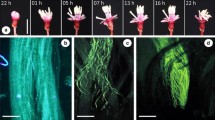Abstract
Heterostyly is clearly confirmed inAconogonon campanulatum. This distylous species is dimorphic for tepals, styles, stigma surface, stamens, pollen grain size, and pollen sexine ornamentation. The floral shape is campanulate and thrum flowers are slightly larger than pin flowers. Small solitary bees were observed as flower visitors and probably effected pollination. The possible evolution of dioecy via heterostyly within the genusAconogonon is discussed.
Similar content being viewed by others
References
Baker, H. G., 1953: Dimorphism and monomorphism in thePlumbaginaceae. 2. Pollen and stigmata in the genusLimonium. — Ann. Bot.17: 433–445.
Barrett, S. C. H., 1990: The evolution and adaptive significance of heterostyly. — Trends Ecol. Evol.5: 144–148.
Bawa, K. S., 1980: Evolution of dioecy in flowering plants. — Annu. Rev. Ecol. Syst.11: 15–39.
Bell, G., 1985: On the function of flowers. — Proc. Roy. Soc. London, ser. B224: 223–265.
Conolly, A. P., 1977: The distribution and history in the British Isles of some alien species ofPolygonum andReynoutria. — Watsonia11: 291–311.
Cruden, R. W., Lyon, D. L., 1985: Correlations among stigma depth, style length, and pollen grain size: Do they reflect function or phylogeny? — Bot. Gaz.146: 143–149.
Dahlgren, K. V. O., 1922: Vererbung der Heterstylie beiFagopyrum (nebst einigen Bemerkungen überPulmonaria). — Hereditas3: 91–99.
Darwin, C., 1877: The different forms of flowers on plants of the same species. — London: John Murray.
Dulberger, R., 1974: Structural dimorphism of stigmatic papillae in distylousLinum species. — Amer. J. Bot.61: 238–243.
Erdtman, G., 1960: The acetolysis method. A revised description. — Svensk Bot. Tidskr.54: 561–564.
Faegri, K., Pijl, L., van der, 1979: The principles of pollination ecology. 3rd edn. — Oxford: Pergamon Press.
Ganders, F. R., 1979: The biology of heterostyly. — New Zealand J. Bot.17: 607–635.
Graham, R. A., 1957: A revision ofOxygonum (Polygonaceae-Polygoneae). — Kew Bull.1: 145–172.
Hassan, M. A., Khan, M. S., 1987: Style-stamen dimorphism inPolygonum L. (Polygonaceae). — Bangladesh J. Bot.16: 93–95.
Heslop-Harrison, Y., 1981: Stigma characteristics and angiosperm taxonomy. — Nordic J. Bot.1: 401–420.
—, 1977: The receptive surface of the angiosperm stigma. — Ann. Bot.41: 1233–1258.
Hong, S.-P., Hedberg, O., 1990: Parallel evolution of aperture numbers and arrangement in the generaKoenigia, Persicaria andAconogonon (Polygonaceae). — Grana29: 177–184.
Hooker, J. D., 1886: Flora of British India. 5. — London: Reeve.
Lousley, J. E., Kent, D. H., 1981: Docks and Knotweeds of the British Isles. — London: Botanical Society of the British Isles.
Proctor, M., Yeo, P., 1973: The pollination of flowers. — London: Collins.
Schoch-Bodmer, H., 1934: Zum Heterostylieproblem: Griffelbeschaffenheit und Pollenschlauchwachstum beiFagopyrum esculentum. — Planta22: 149–152.
Stanford, E. E., 1925: The inflorescence and flower-form inPolygonum, subgenusPersicaria. — Rhodora27: 41–47.
Stapf, O., 1926:Polygonum campanulatum. — Bot. Mag.151: Table 9098.
Vuilleumier, B. S., 1967: The origin and evolutionary development of heterostyly in the angiosperms. — Evolution21: 210–226.
Author information
Authors and Affiliations
Rights and permissions
About this article
Cite this article
Hong, SP. The dimorphic heterostyly inAconogonon campanulatum (Polygonaceae). Pl Syst Evol 176, 125–131 (1991). https://doi.org/10.1007/BF00937948
Received:
Revised:
Accepted:
Issue Date:
DOI: https://doi.org/10.1007/BF00937948




